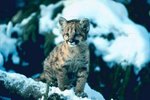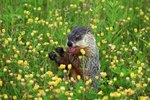
Many waterways and marshes in Central and South America have plentiful populations of animals that look like giant guinea pigs. These are capybaras, the biggest rodents in the world and close relatives of the guinea pig. They are social and live in groups of anywhere from 10 to 30 or more animals and spend their days eating, swimming and hiding from predators. They are an important food source for many local people, but hunting wild capybaras is quickly being replaced by capybara farming.
Adaptations
A quick look at the capybara’s feet provides an important clue to its lifestyle. All of its feet are partially webbed, a helpful trait since these animals normally live next to ponds, streams and lakes and are excellent swimmers. Capybaras also have their eyes, ears and nostrils along the upper portion of their heads in an arrangement similar to that of a hippopotamus. Having everything on top makes it easier for them to see, hear and breathe while they are swimming or relaxing in the water.
Daily Living
Capybaras can live anywhere throughout their range that has the right climate and plenty of water. They are found in forests and open areas, spread across grasslands and deep in marshy areas, but they’re never far from water deep enough for swimming. Their social groups vary in size throughout the year, but a basic group consists of a dominant male, a younger male, a few females and their babies and some youngsters that haven’t yet struck out on their own. Babies spend time with their mothers, but they will nurse from any female in the group.
Diet
A capybara needs plenty of food to sustain its 150-pound body, and the average adult can eat up to 8 pounds of grass and water plants every day. It will also eat fruit and strip the bark from trees. When the capybara eliminates its food after digestion, it will sometimes eat the feces to get the maximum benefit. It also often regurgitates partially digested food and chews it again to aid in digestion, similar to a cow chewing its cud.
Communication
Capybaras are very vocal and stay in touch with one another by using sounds to communicate. If danger threatens one, it will give a sharp bark to warn the rest of the group and all will join in until the whole group is barking. Other sounds the capybara uses include purring, whistling, chirping and huffing. Mothers use these sounds to talk to their babies and the babies often purr as they are nursing. Babies also whistle or purr if they lose the group and continue calling until they are found again.
References
Photo Credits
-
Tom Brakefield/Stockbyte/Getty Images




